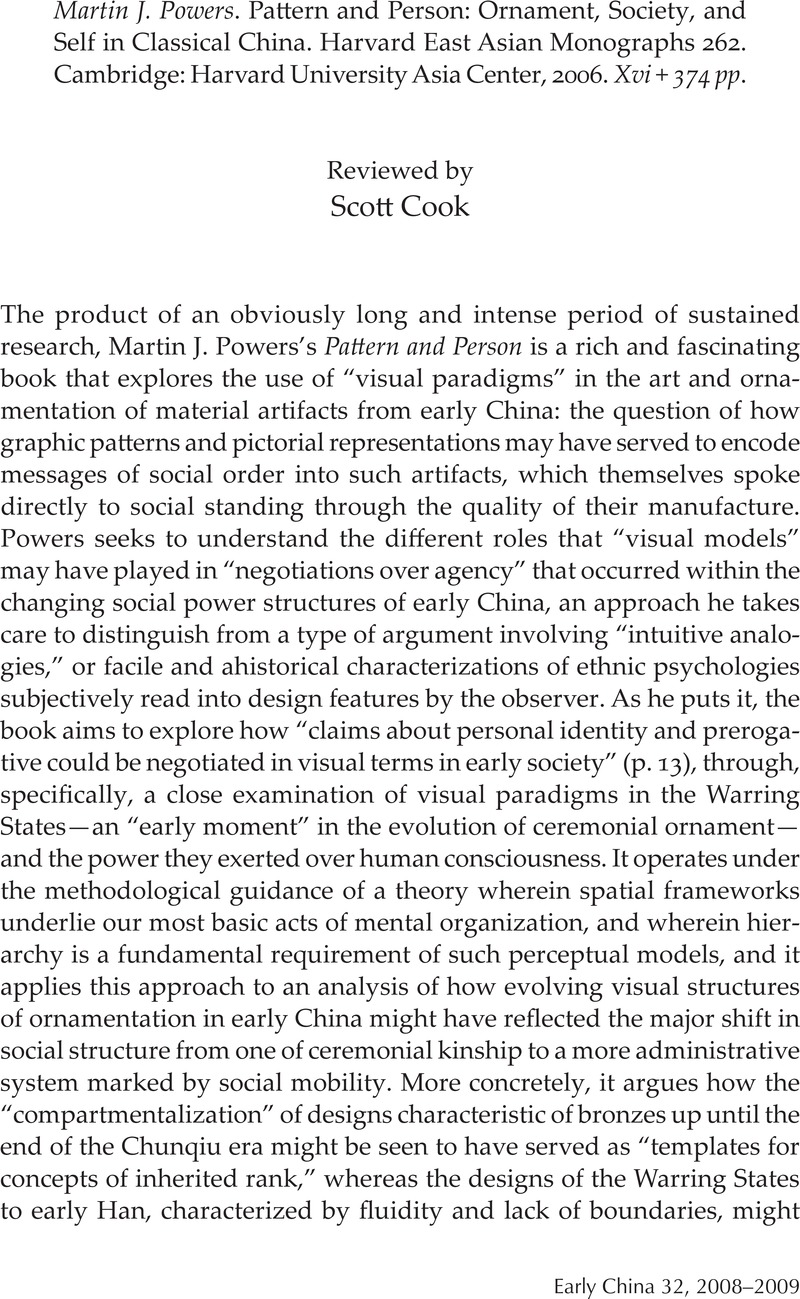No CrossRef data available.
Published online by Cambridge University Press: 08 August 2014

1. Throughout the book, Powers distinguishes between “macro style,” or “a set of identifiable design procedures or algorithms employed by craftsmen in designing their product,” and “micro style,” or the many regional variations that exploit the inherent potential in such rules (p. 43). It is macro style that reveals the systemic priorities of the interest group, and it is this aspect of style that Powers focuses on throughout.
2. Powers's translations are on the whole quite accurate and well rendered. Only in a couple of places do our interpretations diverge in a way that may matter enough to the arguments of the book to note here. One instance is Powers's understanding of the terms 雖無 (i.e., wei wu 唯無) and fei zhi 非直 in the Mozi 墨子 passage on p. 24, where his treatment is inconsistent with the terms' usage elsewhere in that work (or in other texts) and seems driven in part by the way in which he is inclined to interpret the passage—in a separate passage on pp. 128–29, however, he captures the sense of wei wu 唯無 much better. The specifics of this interpretation, however, do not really affect the validity of the overall point he draws from the passage. Another instance of some import is his treatment of the term bi 比 in compounds like bixiang 比象, which he translates “resembled figures” or “calling to mind figures” (pp. 75–77)—a translation upon which his understanding of a dominant early Chinese view of abstract representation to some degree hinges; here, I would be inclined to read the terms more in the sense of “aligning figures side-by-side” or “aligned/contrasted figures.” Finally, in a passage cited on p. 51, Powers chooses to parse against the rhyme of the first two phrases and group liangding 量鼎 (otherwise unattested), rather than du liang 度量, together as a pair. In this, he is simply following a long line of interpretation going all the way back to Zheng Xuan 鄭玄, one perhaps motivated by the desire to read this phrase as strictly parallel to the previous one. Yet du liang 度量 is such a common term-pair in mid-to-late Warring States texts (often matched with such other compounds as fa ze 法則, etc.) that separating the two characters apart where they occur in sequence would seem to demand a stronger justification. This is not so much to discount the long-accepted interpretation as to highlight the fact that there are a number of other important “craft terms,” liang 量 (measure) being one of them, that Powers could have singled out for sustained treatment the way he did for terms like du 度 (degree)—were this not precluded by the inevitable need to impose reasonable limitations on the length of the monograph.
3. One could easily argue that such works as the Lun yu 論語 reflect the same ideological shift.
4. I am in particular thinking of some of his descriptions of the Shanghai Museum hu from the early fifth century B.C.E. and the Freer Gallery bianhu from the late fourth-early third centuries B.C.E., given on pp. 26–37 and 113–16, respectively. See also the comments of Ludwig Bachhofer on the “Huai style” that he quotes on p. 38.